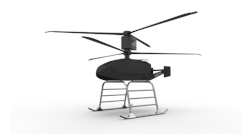As part of the Aviation Expo China 2017 in Beijing, the United Engine Building Corporation (UEC, part of the Rostec State Corporation) will showcase the most advanced Russian developments in engine building as well as discuss some key joint projects with its Chinese partners, including the creation of an engine for a wide-body long haul aircraft (ShFDMS).
The cooperation between Soviet and Russian engine builders with the aviation industry of the PRC started almost immediately after the Republic was founded. The primary focus of the Russian-Chinese cooperation in this area was traditionally concerned with military aviation engines; however, in recent years the civilian vector has increasingly gained prominence.
The interaction between the RF and the PRC in the area of aircraft power units is currently moving from the “seller – buyer” model to the format of a technological partnership that includes joint development of technology as well as prospective technologies and materials for future aviation platforms”, said Victor Kladov, Director of International Cooperation and Regional Policy Department of Rostec State Corporation. This trend is completely in line with the Development Strategy of Rostec State Corporation, whose key goals are increasing the share of civilian products in its revenue up to 50% by 2025 as well as developing high tech civilian products, which undoubtedly includes civilian engine building”.
As part of the Exhibition it is planned to hold negotiations between the UEC and representatives of the Aviation Industry Corporation of China (AVIC), the China National Aero-Technology Import & Export Corporation (CATIC), the Aero-Engine Corporation of China (AECC) and the Commercial Aircraft Corporation of China (COMAC). The negotiations will be centred on cooperation in the design and manufacture of prospective civilian engines, their maintenance service and repairs.
Visitors to the UEC exhibition stand will be able to learn about the capability of Russian AL-31FN and RD-93 engines for fighter aviation, D-30KP-2 for transport aircraft, the latest civilian helicopter engine VK-2500PS and other UEC’s developments.
A number of projects carried out by the UEC in the development of new commercial power engines has also opened the way to putting them on the international market, primarily, on the Chinese one. The UEC has set about creating a civilian high power engine PD-35 for prospective wide-body long haul aircraft. Under the PD-35 program, there is currently research groundwork under way to bring its development to level 6 that will make it possible to implement design and experimental work with minimal risk. A range of high power engines may be created based on the PD-35 engine. The prospective product is planned to have the following features: a lighter design as a result of using special materials; the use of lighter heat-resistant materials in turbine components and in the hot part; a low emission combustion chamber meeting future environmental requirements etc.
The successful implementation of the program of creating a Russian basic PD-14 engine to be used for the Russian passenger aircraft MS-21-300 is making it possible to create on its basis a range of engines with a power range from 9 to 18 tons. Based on the PD-14 gas generator, the UEC is prepared to develop an engine for a prospective Russian – Chinese heavy helicopter AHL in cooperation with its Chinese partners.
In addition, as part of the Exhibition, the UEC has offered Chinese operators of Russian civilian helicopter technology to run a program of upgrading power units by replacing TV3-117 engines with more advanced and powerful VK-2500 models.
“Upgrading is one of the elements of providing an integrated support of the life cycle of civilian helicopter power units in the PRC”, says Alexander Vatagin, Executive Director of JSC UEC – Klimov. The UEC is also actively developing the helicopter engine operation support system of our Chinese customers that includes, in particular, supplying spare parts, technical maintenance and repairs”.
The “helicopter” area is an important component of the cooperation of the UEC with the PRC in aviation engine building. Thus, in early 2017, an inspection of the facility designed to carry out capital repairs of TV3-117/VK-2500 engines was completed at the state-owned mechanical engineering plant Jingjiang in the city of Chengdu. As a result of many years of successful cooperation certificates were issued to confirm that the repair work involving engines for MI-17 civilian helicopters is carried out in conformity with the existing requirements.
Rostec Corporation is a Russian corporation that was established in 2007 to facilitate the development, production and export of high-tech industrial products designed for civilian and military applications. The Corporation comprises over 700 organizations that are currently part of eleven holding companies operating in the military-industrial complex and three holding companies working in civilian industry, as well as 80 directly managed organizations. Rostec's portfolio includes well-known brands such as AVTOVAZ, KAMAZ, Kalashnikov Concern, Russian Helicopters, VSMPO AVISMA, UralVagonZavod, etc. Rostec companies are located in 60 constituent entities of the Russian Federation and supply products to more than 70 countries. In 2016 the consolidated revenue of Rostec reached 1.266 trillion rubles, while the consolidated net income and EBITDA amounted to 88 billion and 268 billion rubles respectively. In 2016, the average salary in the Corporation was 44,000 rubles. According to Rostec's strategy, the main objective of the Corporation is to ensure that Russia has a technological advantage in highly competitive global markets. Rostec's key objectives include the introduction of a new techno-economic paradigm and digitalization of Russian economy.

